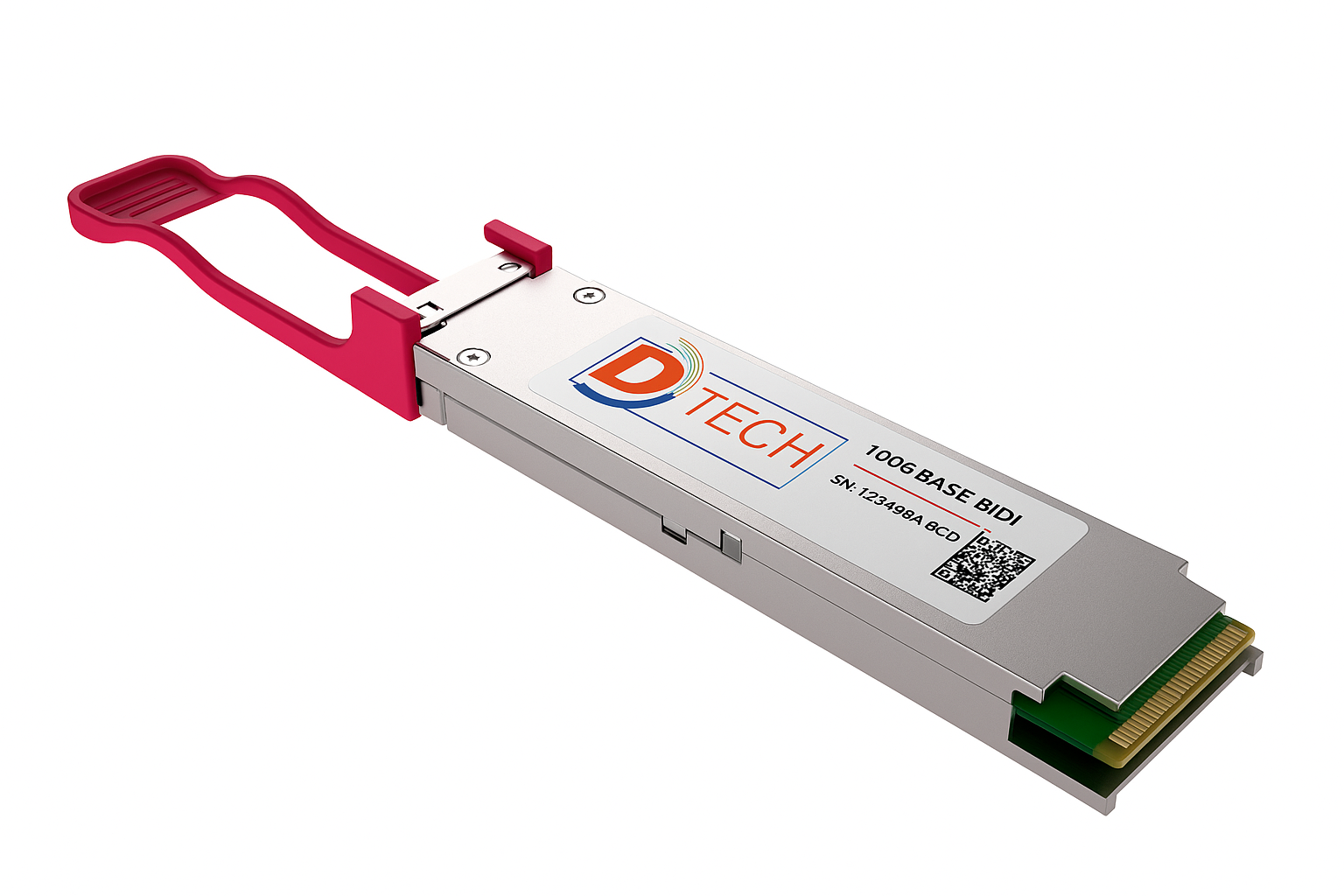100G QSFP28 BIDI Tx1291nm/ Rx1311 nm

Price: Rs 0.00
Product Overview
The 100G QSFP28 Bi-Directional (BIDI) transceiver is designed for high-speed optical communication over single-mode fiber (SMF). It operates using a single fiber strand with duplex wavelength transmission—Tx1291nm/Rx1311nm or the reverse pair.
This module provides reliable 100Gbps data transmission up to 20 kilometers, making it ideal for data center interconnects and 100G Ethernet backbone applications.
Features
Supports 106.25Gbps PAM4 lane signaling rate
Up to 20km transmission over single-mode fiber (SMF)
EML laser and PIN photodiode receiver
4x25.78Gbps NRZ electrical interface (CAUI-4)
KP4 FEC supported inside the module
I²C interface with integrated digital diagnostics (DDM)
Simplex LC optical interface in QSFP28 MSA form factor
Single +3.3V power supply, power consumption <4W
Operating temperature range: 0°C to +70°C
Fully compliant with SFF-8636, SFF-8679, and 100G Lambda MSA LR1 standards
RoHS 2.0 and EU Directive 2015/863/EU compliant
Applications
100GBASE-LR BIDI Ethernet Links
Data Center Interconnections (DCI)
Enterprise and Campus Networks
High-Speed Switching and Routing Platforms
Ordering Information
| Data Rate | Wavelength (Tx/Rx) | Fiber Type | Distance | Connector | Temp Range | DDM | Latch Color |
|---|---|---|---|---|---|---|---|
| 106.25Gbps | 1291nm / 1311nm | SMF | 20km | Simplex LC | 0~70°C | Yes | Purple |
| 106.25Gbps | 1311nm / 1291nm | SMF | 20km | Simplex LC | 0~70°C | Yes | Red |
Absolute Maximum Ratings
| Parameter | Symbol | Min | Max | Unit |
|---|---|---|---|---|
| Storage Temperature | TS | -40 | +85 | °C |
| Supply Voltage | VCC | -0.5 | +4.0 | V |
| Operating Relative Humidity | RH | — | +85 | % |
Recommended Operating Conditions
| Parameter | Symbol | Min | Typical | Max | Unit |
|---|---|---|---|---|---|
| Case Temperature | TC | 0 | — | +70 | °C |
| Power Supply Voltage | VCC | 3.13 | 3.3 | 3.47 | V |
| Transmission Distance | TD | — | — | 20 | km (over SMF) |
Optical Characteristics
Transmitter
| Parameter | Symbol | Min | Typical | Max | Unit |
|---|---|---|---|---|---|
| Center Wavelength | CW | 1284.5 | 1291 | 1297.5 | nm |
| Average Launch Power | PTX | -0.2 | — | +6.6 | dBm |
| Extinction Ratio | ER | 3.5 | — | — | dB |
| Optical Modulation Amplitude (OMAouter) | OMAouter | 2.8 | — | — | dBm |
| TDECQ (max) | TDECQ | — | — | 3.6 | dB |
| Side Mode Suppression Ratio | SMSR | 30 | — | — | dB |
| Power Off (Laser Off) | Poff | — | — | -30 | dBm |
Receiver
| Parameter | Symbol | Min | Max | Unit |
|---|---|---|---|---|
| Center Wavelength | CW | 1284.5 / 1311 | 1297.5 / 1317.5 | nm |
| Receiver Sensitivity (OMAouter) | SEN_OMA | — | -7.6 | dBm |
| Average Input Power | PRx | -10 | +6.6 | dBm |
| Damage Threshold | Pdamage | 7.6 | — | dBm |
| Reflectance | Ref | — | -26 | dB |
| LOS Assert / De-Assert | LosA / LosDA | -26 / -10 | — | dBm |
Electrical Characteristics
| Parameter | Symbol | Min | Typical | Max | Unit |
|---|---|---|---|---|---|
| Differential Input Impedance | Rin | — | 100 | — | Ω |
| Input Voltage Swing (Differential) | VIN,P-P | — | — | 900 | mVpp |
| Output Differential Impedance | Rout | — | 100 | — | Ω |
| Output Voltage Swing | VOUT,P-P | — | — | 900 | mVpp |
| Common Mode Voltage | — | -0.3 | — | 2.8 | V |
| Transition Time (20%~80%) | Tr/Tf | 10 | — | — | ps |
| Power Supply | VCC | 3.13 | 3.3 | 3.47 | V |
Digital Diagnostic Monitoring (DDM)
| Parameter | Range | Accuracy | Unit |
|---|---|---|---|
| Temperature | 0 to +70 | ±3 | °C |
| Voltage | 0 to Vcc | ±3% | V |
| Tx Bias Current | 0 to 100 | ±10% | mA |
| Tx Output Power | -0.2 to +6.8 | ±3 | dB |
| Rx Input Power | -10 to +6.6 | ±3 | dB |
Communication Interface Timing
| Parameter | Symbol | Max | Unit | Description |
|---|---|---|---|---|
| Initialization Time | t_init | 10 | s | Time from power-on or hot-plug until module is fully operational |